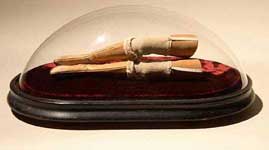November 17 - January 2, 2006
Children of the Cabinet: A Contemporary Experiment with the Wunderkammer
Works by Elltiott Arkin, Peter Blake, Christine Marie Davis, Holly Laws, Paul Etienne Lincoln, Wolfgang Stiller and Martin Wilner
At the end of the 17th century a physician and theoretician, Johann Daniel Major, described Wunderkammer as “scattered/deliberate disorder.” In as much as this description is paradoxical, it, in essence, captures what Wunderkammer was: a venue for collecting and organizing objects, whether they be organic or man-made, in order to facilitate the understanding of these objects in relation to each other and in and of themselves. Major’s description is no less fitting when attributed to the contemporary experiments with the ‘cabinets of curiosities,’ examples of which are present here.
The artists featured in “The Children of the Cabinet,” have explored the form and ideology of the Wunderkammer through various means and mediums. Works by such artists as Wolfgang Stiller, Paul Etienne Lincoln or Holly Laws hold most true to the formal element of the Wunderkammer. Their work begins with a skeleton that is a cabinet, box or vitrine that they then proceed to fill with ‘marvels’ and ‘curiosities.’
Wolfgang Stiller fills his cabinet with organic forms such as amphibian skeletons and organs. In a sense, his works are what a 17th century natural sciences historian, Robert Hook, called “monuments of nature.” Paul Etienne Lincoln’s ‘boxes,’ on the other hand, contain man-made marvels. In his Passage to Purification, he fills a cloth covered box with 24 silver prints that illustrate a performance with a curious looking machine and laboratory equipment. Then there are Holly Laws’ vitrines which she fills with sculptures of human limbs and other body parts.
Some of the other artists featured here think, so to speak, outside of the box. Christine Marie Davis’ work, although no longer confined to the walls of a box or vitrine, maintains the collection/assemblage aspect of the Wunderkammer. Her sculptures are assemblages of both organic materials such as “hair, fur, leather,” and man-made materials such as, “ceramic, glass and metal.”
Works by Peter Blake and Martin Wilner seem most removed from the formal aspect of the Wunderkammer, in the sense that their work is two dimensional. However, their work maintains the ideology of the Wunderkammer as a calculated collection of disparate objects.
Peter Blake makes collages of popular culture images such as postcards, stamps, clippings from magazines and ticket stubs. As such he creates collections of the detritus of pop culture. Martin Wilner’s works, although at first glance appear to be collages, are ink on paper drawings. Yet, these drawings, in a sense, render a collage of different images that are collected and organized in the artist’s mind as memories. These disparate images, when juxtaposed, create a coherent narrative of events, places and faces that made history.
Elliott Arkin works with an entirely different element of the Wunderkammer, namely the 17th century experiment called automata. Many of the 17th century artists were intrigued by science of motion and strove to give their sculptures lifelike abilities such as movement. Elliott Arkin’s sculptures are a contemporary twist on such mechanized sculptures.
In essence, this show explores the role of the artist as collector: an individual, who removes objects from their original or natural context, organizes them such that they can be understood in and of themselves, and in some cases animates them.
-Joanna Krzyzanowska
______________________________________________________________________________________
All That Glitters
Works by Denise Azira, Nicole Cherubini, Andrea Corsan, Gabriella Kiss, Diana Kingsley, Ted Muehling, John Noestheden, Kiki Smith, and Gregg Wolf
The evolution of jewelry design runs parallel to that of art styles. In the early 17th century the Georgian jewels included brooches decked out in clusters of large gems and tiaras. The 18th century Victorian jewels were inspired by Greek and Egyptian designs. The Art Deco jewels played with patterns of bright contrasting colors. These are just a few trends that have emerged in the ever changing world of jewelry design. The artists featured in “All That Glitters,” amongst them Denise Azira, Nicole Cherubini, Andrea Corsan, Gabriella Kiss, Diana Kingsley, Ted Muehling, John Noestheden, Kiki Smith and Gregg Wolf, have crafted exquisite pieces that simultaneously are of our time and allude to past stylistic trends.
“All That Glitters,” brings together a great corpus of works by these contemporary artists, which includes both wearable jewelry and conceptual works with jewelry as the underlying theme. Many of the works draw their inspiration from nature - some by being vaguely reminiscent of flora and fauna while others by outright mimicking it. Other pieces are inspired by technology and others yet by mythology. There are also pieces which explore, so to speak, a theme that is self-reflexive. These are the non-representative pieces, the focus of which is purely aesthetic adornment and embellishment. Yet, irrespective of the various themes, there is a single underlying objective that is explored by all these artists and that is also the objective of “All That Glitters.”
The salient objective of this show is to explore the continuing allure of jewelry that has captivated us for centuries. Whether it be an amulet or bling-bling, or whether it be a symbol of love or power, jewelry has always been an epitome of the object of desire. This is the aspect of jewelry that has been omnipresent throughout the globe and resilient to change despite the evolving trends.
Get ready to be razzle-dazzled.

